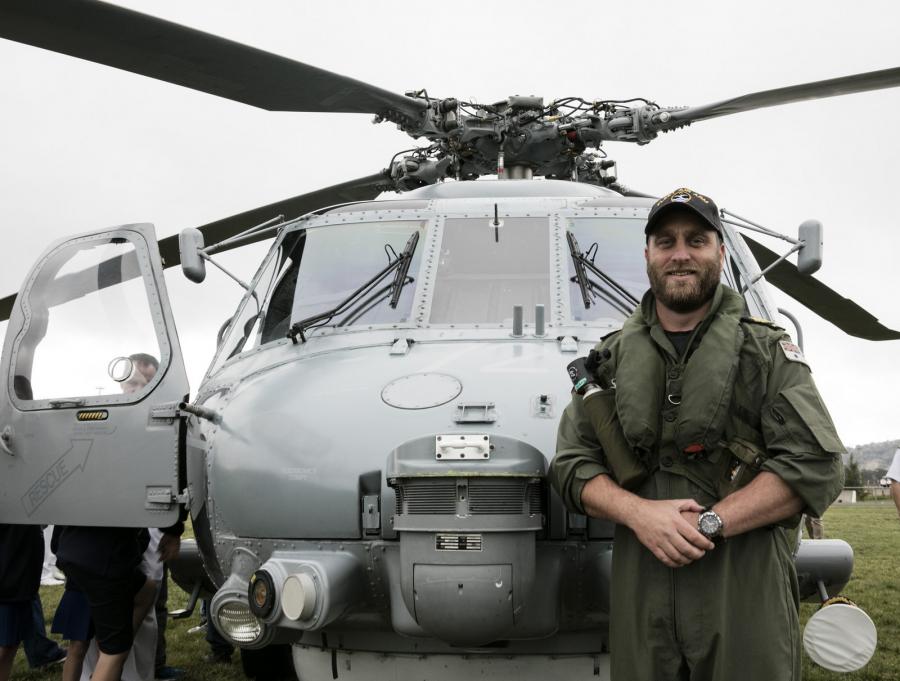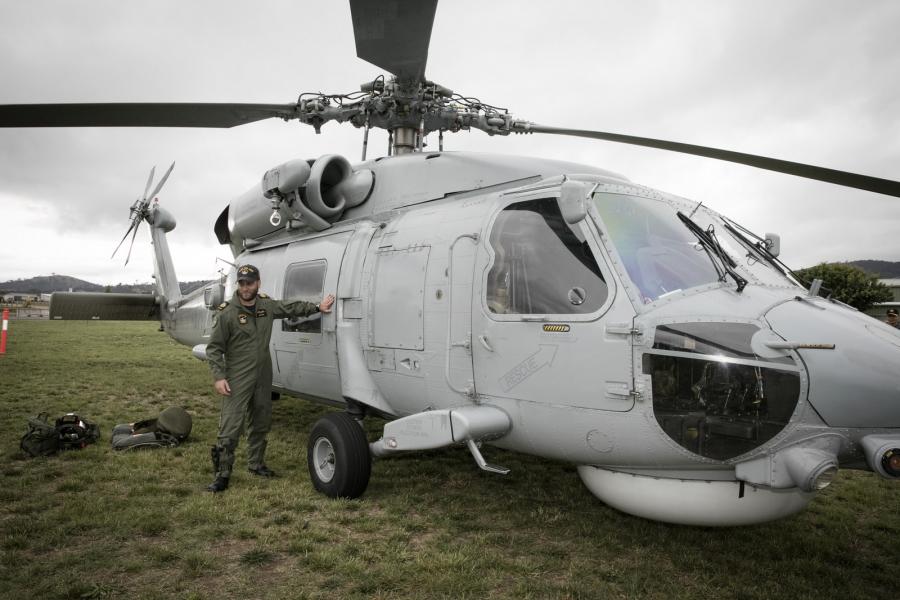'Every time you get in it you feel safe – you know you’re coming home'

It was a grey, wet day in Canberra and a day of mixed emotions for Warrant Officer Benjamin Sime as he climbed out of the Royal Australian Navy’s last operational Seahawk “Bravo” helicopter for the final time.
The helicopter, affectionately known as Christine, has been donated to the Australian War Memorial, and Sime and the crew completed a final flypast over the Memorial and Parliament House before the official handover ceremony.
“I don’t want to try and say it wasn’t emotional, because it was actually quite emotional bringing it in for the last time,” Sime said.
“I’m very passionate about the Seahawk. I’ve been flying in the Seahawk for approaching 18 years … It’s an unbelievable machine. It’s so reliable and the best thing about the Seahawk is that every time you get in it you feel safe – you know you’re coming home.”
For Sime, Seahawk 872 is particularly significant. On 24 April 2004, he was serving as a sensor operator on the Seahawk in the Persian Gulf. The helicopter was operating off HMAS Stuart when terrorists in fishing dhows launched a series of attacks against Iraqi oil terminals. One of these dhows, packed with explosives, detonated when a boat from USS Firebolt drew alongside to investigate. Three American sailors were killed and four were seriously wounded in the explosion.
Following several unsuccessful attempts to rescue survivors, Sime leapt from the aircraft in his flying gear to help a badly wounded sailor.
“He had a severe head laceration … he was struggling to stay afloat,” Sime said. “He actually let go of the [rescue] strop at this point and then lay face down in the water and it was evident he was unconscious …
“At that point I jumped from the aircraft to try and render assistance … [I] turned him over the best I could and tried to render some sort of first aid in the water. At this point in time it was night so … it was a little bit challenging. At the end of the day all I could do at this point was just support him as best I could and keep his head out of the water.
“We managed to get the casualty onto … the patrol boat and that’s where we continued to try and do CPR. It was … pretty chaotic at that point – there were bodies being recovered from the water … and there were a lot of people in distress clearly and it was very hectic.”
During the incident, two further attacks were launched against oil terminals to the south. Sime continued to help the American sailors and was later awarded the Medal for Gallantry in recognition of his bravery.
“I don’t want to use the cliché of ‘you’re relying on your training and you rely on the people around you,’ but that is really the case,” Sime said. “We all worked together extremely well as a crew and we just went about doing what we had to do. In all truthfulness, no, I wasn’t [scared] …… it was just one of those circumstances where you just do what you have to do and worry about it later.”
Sime managed to get the injured sailor to the patrol boat and then to a doctor on HMAS Stuart, but the sailor died of his wounds.
“In later years obviously you still think about it,” Sime said. “It happened on the 24th and it went over into the 25th, so obviously being Anzac Day, every year when Anzac Day comes around for us, and for me personally, it just has my own personal spin on what it means for me.”

Warrant Officer Benjamin Sime after the Navy's last operational Seahawk "Bravo" helicopter completed its final flight.
Commander Rick Allen, who was the mission commander in the Seahawk with Sime on that day, agreed.
“It’s the sort of thing it’s taken its rightful place in our memories, but at the same time it’s something you don’t stop thinking about,” Allen said.
“And when you meet with friends and colleagues and people who were there that day, or for me today and seeing this particular aircraft and knowing that this was the aircraft that we worked with that day, that night, and knowing how hard the team worked, it does bring those memories back.
“It was a very uncertain time. It was right on last light so it was dark and we were very unsure of what had occurred. We didn’t know if it was an accident or an attack as it wasn’t clear at first. It only actually became clear as the minutes unfolded, but there was a pressing need to put Ben into the water to be able to try and sustain life in the water and he unflinchingly did that, so it’s something that we’ve always held very close in our memories.
“We had an idea that Ben was sort of safe and that he was looking after the survivors from the Firebolt in the water, and that he’d actually perhaps even been picked up by a boat, but we did lose track of him, and it was a very daunting sort of a thing to be faced with that.”
For Allen, it was particularly special to see the Seahawk complete its final flight and to know that it was going to be preserved at the Memorial.
“It’s a day of mixed feelings really,” Allen said. “It’s amazing to finally come to this point in time and see the last flight of the last aircraft, and for me it was an aircraft that I had a very close association with … It a means an enormous amount to me personally. I was very chuffed, very thrilled that this particular one of the 16 was the one chosen [to go to the Memorial].”

Commander Rick Allen with his daughter Philippa: "It a means an enormous amount to me personally."
For Sime, it was a sad, but proud day to see the last Seahawk “Bravo” retired.
“I’m very proud to be able to fly her over to the War Memorial,” he said. “I love 72 because I’ve got that connection with her …
“She was affectionately named Christine because you never knew what was going to happen in regards to the avionics, but I will say one thing, when we did deploy with her there was not one issue at all. She performed 100 per cent. We flew every flying hour. She was never unserviceable. So she just knew when she had to work and when she didn’t have to work.
“The platform’s done a lot of things over its timeframe, whether it’s operational deployments, or assistance to the community [during search-and-rescue operations or] cyclones or fires. Sixteen were introduced in service and 16 are retired so that’s quite a remarkable feat for the platform.
“I’m very proud to be a part of the Seahawk history … [and] I’m very, very proud that 72, the aircraft that we embarked with to the Gulf, the North Arabian Gulf and Iraq, is going to the War Memorial.”